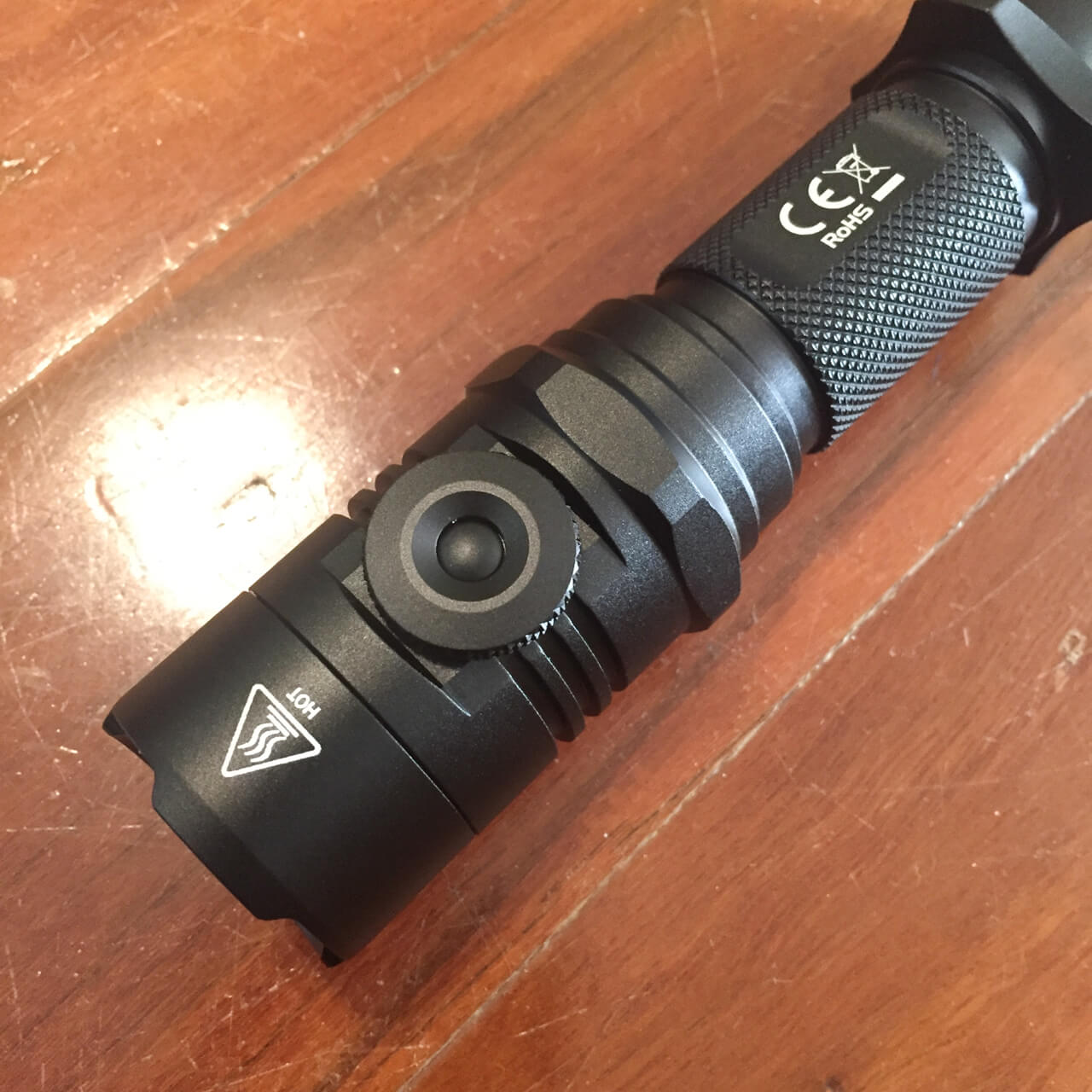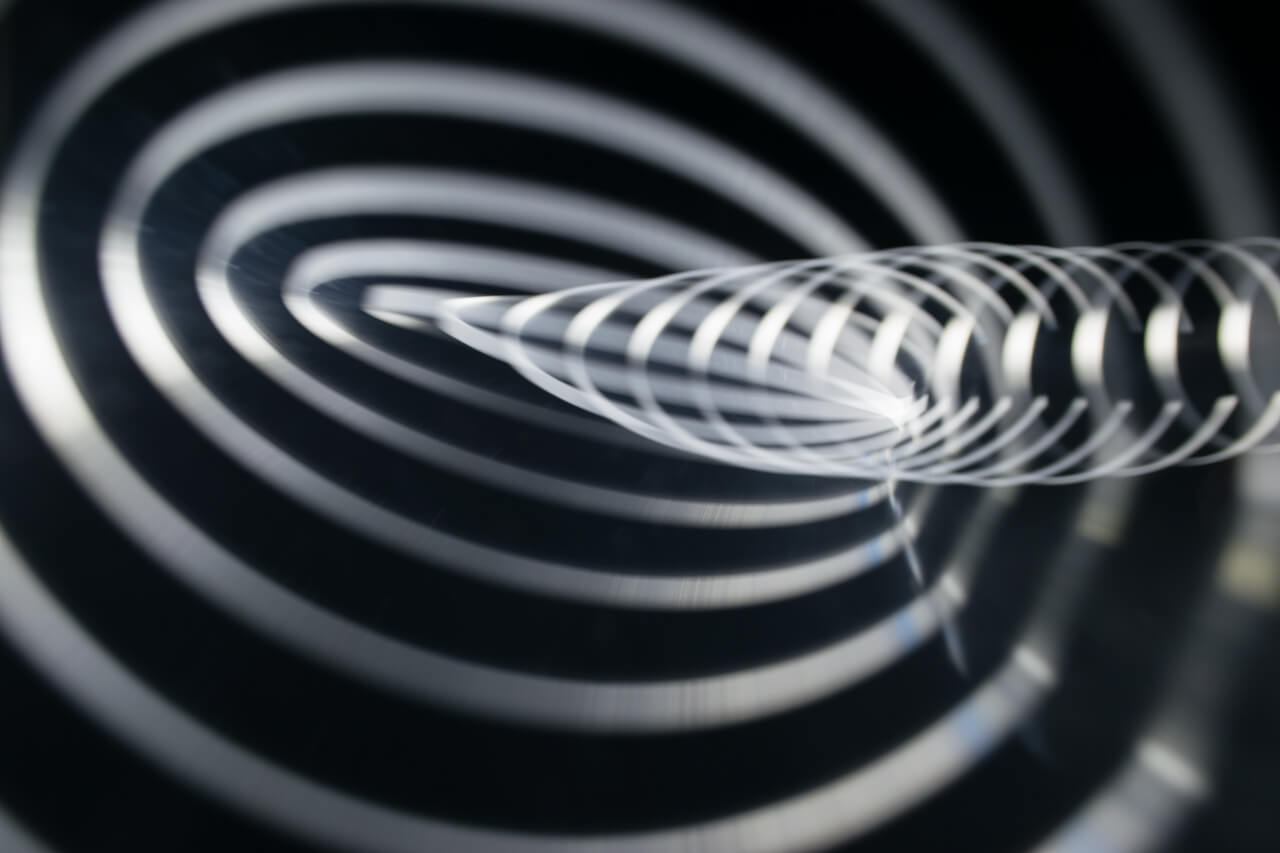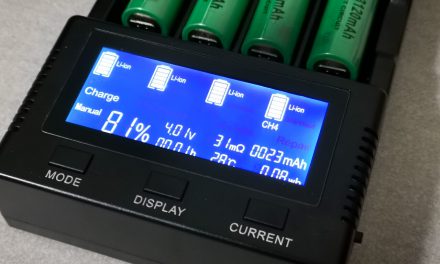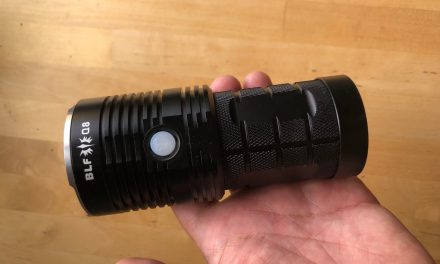
Flashlight Review: Nitecore P26

The Nitecore P26 is an 18650 battery flashlight (torch), with a rotary dial for brightness and a momentary tail switch for controlling on and off. This review takes a look at this interesting user interface, to see how it performs for light painting art.
Disclaimer
The Nitecore P26 was sent to me for an honest review by FastTech. I receive no commission from links or sales. Product Link.
Construction
The Nitecore P26 arrived in a Nitecore branded cardboard box. Included in the box were the flashlight, clip, lanyard, holster, and spare O-rings. Optional accessories include the RSW1 remote pressure switch and cone diffusers.
The Nitecore P26 uses a single li-ion 18650 battery, and has a 31.8mm diameter head that is wider than the battery tube. This larger head allows for a relatively high peak beam intensity, and easily fits in commercial light painting connectors such as the Light Painting Brushes Universal Connector and Herramientas Cone. A rotary dial switch is located on the head, and a tail switch is located at the tail. The light has good knurling for grippy-ness. There is also a tactical ring and crenelated bezel for “tactical” people.

Nitecore P26 Rotary Dial
The tail cap and head can be unscrewed, with the former used for battery insertion.Partial unscrewing of the tail cap will lock the light to prevent accidental activation. Due to physical reverse polarity detection and the shock protection system, only li-ion 18650 batteries with button tops will fit. I had no issues with fitting obese protected batteries such as the Klarus 18GT-36. Unprotected button top batteries such as a Sony VTC6 with added button top also fit OK. Two CR123A or RCR123 batteries can also be used. The shock protection system, whilst designed the flashlight being attached to guns (to reduce the impact from recoil), should also reduce the chance of damaging batteries during a drop.

Nitecore P26 – Head, Tube, and Tail
There is no internal USB charging and no included 18650 battery. This may reduce appeal to the consumer market. Personally, I prefer to use dedicated analysing chargers for charging and testing 18650 batteries anyway.
User Interface
The big feature of the Nitecore P26 is the combination of a rotary dial for brightness, and a momentary (forward clicky) tail switch.
The rotary dial is placed near the head. Turning it anti-clockwise moves from 0.5 to 1000 lumens output. If you keep turning it, the light goes into strobe mode. There is a slight click before strobe mode, but it is easy to accidentally advanced into strobe mode when not intended. Turning the rotary dial clockwise does the above in reverse. The rotary dial is also accessible when in commercial light painting connectors such as the Light Painting Brushes Universal Connector. I also found that the dial stayed in position whilst in the connector.
The great advantage of this rotary dial is that you can set any output level between 0.5 and 1000 lumens. I found this very useful for fine tuning the perfect brightness levels required for a light painting scene, rather than dealing with steps in brightness of up to x10 on some other flashlights. The downside with no discreet output levels (e.g. 100, 500, 1000lm) is that you have to guess the output level by eyesight, something which humans are generally not good at. This is not great for consistency between light painting sessions, and makes it difficult to estimate remaining battery runtime as well. Users should be aware of both the advantages and disadvantages.
I prefer the rotary dial method of fine tuning brightness compared to lights with “ramping” user interfaces, such as the BLF Q8 (which also has discreet modes), Thrunite TH20 headlamp, and Emisar D1S. This is due to ramping user interfaces rarely having choice in which direction the ramping will occur (either up or down), which makes it difficult for example to make a small adjustment down in output if the light has to ramp up to full output and then down the desired output.
The strobe is a very fast single frequency strobe, estimated at 19.5Hz, and 33% on time. The strobe is at maximum output. It is probably asking too much for a variable output strobe as well!

Nitecore P26 Strobe – 19Hz
The tail switch is a momentary switch, also known as a forward clicky or tactical switch. A full press turns the light on at the brightness set by the rotary dial, including strobe (mode memory by default). A full press then turns the light off. A half-press turns the light on for as long as the switch is depressed. This is very useful for light drawing. There is a lot of resistance before engaging in full on, making this a fantastic momentary switch to use for light painting.

Nitecore P26 Tail Switch
The P26 can also be controlled by an optional RSW1 remote pressure switch, which can be useful in some use cases when accessing the tail switch may be tricky, such as light blading.
Beam and Output
The Nitecore P26 has a deep smooth reflector, a Cree XP-L HI V3 LED, and an anti-reflective lens. This results in a “throwy”, small, high intensity hotspot, at up to 24,000cd peak beam intensity. This is quite impressive for the size of the light, and the reasonably conservative (for 2018) output of 1000 lumens. The spill beam is wider than similar lights such as the Klarus XT11GT, and thus more useful for wayfinding. The emitter is cool white, I would estimate at around 6500k, with the usual Cree XP-L HI tint shift evident. It is cooler white than many similar lights, with the Colour Rendering Index (CRI) in the usual low 70s.
The beam profile with a small hotspot is excellent for the LPB Light Whip. By default, the hotspot is too narrow for illuminating longer light painting tools (sword, tubes, light flutes) and light blades. Beam diffusing (using diffusing film such as D-C-Fix) may result in a more optimal beam profile. (Note: you can diffuse a “throwy” beam, but you cannot intensify “floody beams”). It is not good for illuminating tools with wider light input requirements such as fibre optic brushes unless you use a beam diffuser. The P26’s little brother, the Nitecore MT22C has the same user interface and max output, but with a floodier beam that may be better for most light painting tools. The rotary switch on the MT22C may be less accessible inside commercial light painting connectors though, due to the slightly narrower head.
Output varies between 0.5 and 1000 lumens. The range of output levels is great for multiple purposes. 1000 lumens is quite conservative in 2018, where outputs of 1500 to 2000 lumens can now be found in 1×18650 flashlights. However, this has the advantage of good heat handling as the light takes longer to reach excessive heat levels. At 1000 lumens, the light lasted for 6 minutes until the Advanced Temperature Regulation (ATR) module gradually stepped down the output during the next 3 minutes to approximately 65% of the original output. From there, the light remained with stable 65% output until around 70 minutes, where the output gradually declines to minimal light output by 120 minutes. The excellent heat handling and regulation means that the P26 is great for longer light painting scenes, where step-down is not desired mid-scene.
There is no Pulse Width Modulation which is a big improvement over the otherwise excellent Nitecore P10GT.
Conclusion
Things I liked:
- Very easy to use
- Momentary tail switch can be used for all output levels and strobe
- Rotary dial (side switch) allows for fine tuning of brightness
- Rotary dial (side switch) is accessible in light painting connectors
- Mode memory for any output level including strobe (by default)
- Good brightness
- Good build quality
- Excellent heat handling, and takes 6 minutes until step-down
- Single frequency strobe
- Optional remote pressure switch can be used
- No PWM
Things I didn’t like:
- No discreet output level options – difficult to guess output and remaining runtimes
- Only accepts button top 18650 batteries
- No internal USB charging or included battery
- Hotpot is too narrow for most light painting tools – may need diffusing
Nitecore are consistent at producing quality flashlights, and the P26 is no exception. There are advantages and disadvantages of having variable output that the user needs to be aware of. This light has a great combination of a rotary dial for brightness selection, single frequency strobe, momentary tail switch, and excellent heat handling. You will need to supply your own 18650 battery and charger though. Unfortunately the default beam profile of this light is sub-optimal for many light painting tools. You may also want to consider the slightly slimmer, but more “floody” Nitecore MT22C instead.













